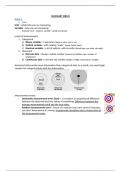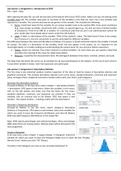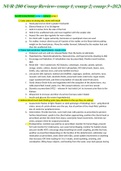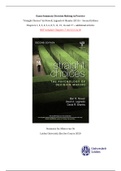H:
• Hypernea: taking deeper breaths than usual
• Hypernoea: slightly deoxygenated blood
I:
• Ischaemia: insufficient supply of blood to an organ or tissue
• Isocapnic: Maintaining a costant concentration of carbon dioxide in the blood or tissues
T:
• Tachypnea: Abnormally rapid breathing
Lab report information
Overview
What is the report about?
• Estimation of exercise intensity using oxygen uptake, heart rate and blood lactate data (time to exhaustion is also
useful- this is applicable if bouts went on for less than 6 minutes)
• From this data (alone or in combination), can we estimate the intensity domain that a bout of constant work rate
exercise was conducted in?
o No knowledge of boundaries that we know separate the exercise domains (VO2 max, LT/GET, CP/MSS)
o Also, you will not know the maximal oxygen uptake
Data collected:
• 2 exercise intensities- lower and higher exercise intensity bouts
• Collection of gas exchange (throughout), HR (every minute), blood lactate (before and after bout 1 and after bout 2)
(can use the before value for bout 1 for baseline for both bouts)
o 2nd bout was max. 6 minutes in length or to exhaustion
Data:
• There is a complete data set available for 6 individual bouts from a range of intensities
• You must analyze data for all buts and provide an estimate of the domain (or explain why it is not possible to say for
sure)
o Perform calculations indicated in the data file- there are marks for this
o It is ok to sit on the fence with some of the bouts!
• You must refer to the data filed that you are using by the codes indicated. This is to allow your calculations and
estimate of the domain to be checked (filed are coded B1-B6). DO NOT RENAME FILES
Additional analyses:
• Videos on ELE (and calculations on data sheet for heart rate and blood lactate data) indicate further calculations to
be made (gain or cycling economy, oxygen uptake slow component)
• Gain= change in vo2/ change in work rate
o How much oxygen the participant is consuming for the work rate that is being completed
o Bigger gain value- more oxygen needed to perform a set amount of work
• Indication of vo2 slow component =end exercise vo2- vo2 at 3 mins (point at which we are 3 mins into loaded
exercise)
o Larger value= larger vo2 slow component
o Slow component does not appear in some bouts of exercise
LOOK FOR:
• Pattern of vo2 oxygen uptake
o Put a figure together
, o Steady state reached?
o Is there a slow component?
o Is it still increasing at the end of exercise
• Blood lactate level (can be the most important piece of data)
o Is the participant likely above or below the lactate threshold?
▪ I.e.,>1mM increase above the baseline value
▪ If below the lactate threshold- they must be in the moderate domain of exercise
▪ Magnitude of how far they are above the threshold gives some indication of what domain they
are conducting in
o What is the value at the end of the exercise?
• Heart rate (considered in a similar way to oxygen uptake)
o Steady state? (Has the heart rate levelled off from the 3rd minute to the end of exercise)
o Does it increase after 3 minutes?
o End exercise heart rate (calculate as a % of estimated max: 220-age) (when looking at higher exercise
intensity domains)
▪ If we have hit 100% HR max, they must be in the extreme domain
• Time to exhaustion (if reached under 6 minutes)
o Indicates that this intensity of exercise is above the MSS (severe or extreme)
o Can use end exercise HR data to then determine which one of these it was
To start:
• Background reading/ lecture slides- be able to describe the physiological responses to exercise in the different
domains
• Analyze the data (calculations) and cross check against the characteristics/ classify bouts
• Create figures and tables that display the pertinent data (I.e., figure to show heart rate against oxygen uptake)
Cycling economy gain
Gain:
Cycling economy and gain are the same thing: how much oxygen is being consumed for a given amount of work
• Calculated easily if lab data has been collected using a step test
o = increase in VO2 above BL/ workload (-20W)
• Higher indicates an individual is using more oxygen per watt of exercise (less efficient)
(BL= baseline cycling period)
Should divide by the CHANGE in work rate
• *VO2 must be in ml (baseline is the average vo2 from –20, -10 and 0s; exercise in the average vo2 from 340, 350,
360s)
o Time 0 is when the load was added
o If bout was less than 6 minutes, use the last 3 cells (last 30s)
o Can calculate gain for all bouts given
• **20W is the minimum “unloaded” power and represents the internal resistance of the ergometer (need to account
otherwise we get an overestimate)
• Gain= mL.min-1.W-1
• The higher the gain, the more oxygen is being consumed per watt of external power output
• It may provide information regarding which intensity domain a participant is exercising in; however, it needs to be
used alongside other data
Rough guide to gain (Wilkerson et al; 2004):
• Moderate= 8-11mL.min-1.W-1
• Heavy= 9-12 mL.min-1.W-1
• Severe= 8-14mL.min-1.W-1
• Extreme= <8mL.min-1.W-1
,**these values are broadly corrected for most people, but significant inter-individual variation can occur in moderate and
heavy values (e.g., much higher values are seen in individuals with a greater % of type 2 muscle fibers)
**there is also considerable overlap between the thresholds
**if a gain value is given, it could be in various domains- need other data
**variation is seen due to the oxygen uptake slow component- in combination with time to exhaustion, can introduce
variability e.g., if severe intensity- can have the broadest range
o Upper end of severe domain, we will reach exhaustion quickly and oxygen uptake will not have a chance to
get to the values it needs to be
o At lower end- there is the biggest scope to increase up to vo2 max due to the largest slow component, so
therefore biggest gain
Exercise intensities:
• Moderate: below LT
• Heavy: above LT, below MSS
• Severe; above MSS achieving VO2 max
• Extreme- exhaustion before VO2 max
Gain continuum
GAIN DATA COMES SECOND TO OTHER DATA- DO NOT RELY ON GAIN DATA TO DETERMINE THE DOMAIN
• When we exercise at different intensities, there is a distinct pattern emerging for the response of gain/cycling
economy
• For moderate intensity exercise, we get a value that
is consistent across the whole range of moderate
intensity exercise of around 8-10mL.min-1.W-1
• Above the LT, is the heavy domain and there is a
change in the gain as we go through the domain.
o Closer to LT- lower gain within heavy
domain(still higher than moderate)
o 20% higher as we get to MSS, anything up
to 12mL.min-1.W-1 (but there is variability)
• Dramatic change at the severe domain- highest gain
values seen are exercise intensities just above MSS
(because even if just a few watts above MSS- project
Gain values: VO2 to the maximum)
Moderate 8-11mL.min-1.W-1 o Comes down as we go through the severe
Heavy 9-12mL.min-1.W-1 domain because there is a ceiling of VO2
Severe 8-14mL.min-1.W-1 max- represented by next yellow line
Extreme <8mL.min-1.W-1 o When there is attainment of VO2 max, if
**Gain is determined by how the primary VO2 increase we have the smallest power output
and slow component VO2 responds to power output eliciting this- there is the biggest increase
in VO2 divided by the smallest increase in
power output, and thus the gain is large
o **as we go through the severe domain, we
are dividing the same number (VO2 max)
by increasingly bigger outputs- so severe
domain gain decreases as you go through
• Extreme domain- downward trajectory continues-
the gain values down to around 6mL.min-1.W-1 and
potentially even further)
o This is because the power output is getting
bigger and dividing by a smaller number
each time the power output increases
o Extreme exercise is characterized by not
attaining the VO2 max
Scenarios for gain at lower end (around 8) Scenarios for gain at higher end (towards 12)
, • Moderate: subject has good exercise economy • Moderate: subject has poor exercise economy
• Heavy: subject has very small/ indistinguishable slow (consuming poor oxygen per watt of exercise
component (exercise is likely to be only just above conducted)
the lactate threshold) (often only 1-1.5mmol above • Heavy: subject has a large slow component (VO2
baseline value) slow component can take the VO2 above the MSS
o Dividing a value in the heavy domain by a but at a power output below MSS)
larger power output (therefore getting a o Gain for exercise is closer to MSS
value on the lower end) • Severe: subject has a very large slow component
that has resulted in the attainment of VO2 max
• Severe: work rate is likely towards the severe/
o Exercise near the heavy/ severe boundary
extreme boundary:
• Extreme: the closer to the severe/ extreme
o Gain gets lower throughout the severe
boundary, the higher the gain in extreme exercise
domain (dividing same end value by a
bigger number)
o Vo2 max achieved quickly and a larger
power output
• Extreme: gain will be lower the further into the
extreme domain the bout is conducted (values can
be 5 or lower if at higher end of extreme domain or
7/8 if slightly into that domain
**IT IS THE POWER OUTPUT MSS NOT THE VO2 MSS THAT DETERMINES THE DOMAINS
Look at heart rate value to clarify what domain
Oxygen uptake slow component
What does EE-3 reveal?:
• =End exercise- value at 3 mins into loaded exercise
• Estimate of the magnitude of the VO2 slow component
• DO NOT SEE INCREASE HAPPENING EARLIER
ONLY SEEN ABOVE LACTATE THRESHOLD
• VO2 slow component is only evident above the lactate threshold- useful in combination with other data to confirm
estimate of the domain and provide a more accurate estimate of where in a domain exercise is occurring
• In the heavy exercise domain, the magnitude of the slow component increases throughout
• Largest slow components are generally noted just into the severe domain- for the increase in work rate, the vo2 slow
component has the biggest scope increase
o If above MSS, we will reach maximal oxygen uptake
o If vo2 is the maximum ceiling- if we have enough range (just into severe domain) there is the greatest
amount of time- so slow component is biggest
o Slow component is smaller the more into severe domain due to less time and exercise intensity is very
short
• Magnitude of the slow component is reduced at the upper end of the severe domain
o The response is dominated by the primary increase in VO2- vo2 is projecting towards vo2 max. The early
increase in vo2 that dominates the response doesn’t leave much room for the vo2 slow component to
manifest
o The response has a “ceiling” of VO2 max
o Exercise duration is short
EE-3: (can only be used if you have a minimum of 4 mins of loaded data)
• =average vo2 in last 30s of exercise- average vo2 from 170-190s
o 170-190s is the 3 mins into the loaded exercise
• The bigger the number, the bigger the vo2 slow component










